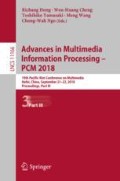Abstract
With the development of convolutional neural networks, generative models can synthesize really wonderful images. But most of these models are limited in generalization and extensibility. And things become difficult when generating images with multiple specified features. Therefore, this paper introduce an expandable approach to generate images with multiple features. We use our model to generate images including a single character with specified fonts and position, by learning the representations of different features from existing images, and using these representations together. Several structures are proposed to increase the training efficiency and extensibility. Finally, we arrange some experiments and show the performance of our model.
Access this chapter
Tax calculation will be finalised at checkout
Purchases are for personal use only
References
Chen, L.C., Papandreou, G., Kokkinos, I., Murphy, K., Yuille, A.L.: Semantic image segmentation with deep convolutional nets and fully connected CRFs. Comput. Sci. 4, 357–361 (2014)
Clevert, D.A., Unterthiner, T., Hochreiter, S.: Fast and accurate deep network learning by exponential linear units (ELUs). Comput. Sci. (2015)
Goodfellow, I.J., et al.: Generative adversarial networks. In: Advances in Neural Information Processing Systems, vol. 3, pp. 2672–2680 (2014)
He, K., Zhang, X., Ren, S., Sun, J.: Deep residual learning for image recognition. In: Computer Vision and Pattern Recognition, pp. 770–778 (2016)
Hinton, G.E., Salakhutdinov, R.: Reducing the dimensionality of data with neural networks. Science 313(5786), 504–507 (2006)
Isola, P., Zhu, J., Zhou, T., Efros, A.A.: Image-to-image translation with conditional adversarial networks. In: Computer Vision and Pattern Recognition, pp. 1125–1134 (2016)
Kingma, D.P., Rezende, D.J., Mohamed, S., Welling, M.: Semi-supervised learning with deep generative models. In: Advances in Neural Information Processing Systems, vol. 4, pp. 3581–3589 (2014)
Kingma, D.P., Welling, M.: Auto-encoding variational bayes. In: International Conference on Learning Representations (2014)
Krizhevsky, A., Sutskever, I., Hinton, G.E.: Imagenet classification with deep convolutional neural networks. In: International Conference on Neural Information Processing Systems, pp. 1097–1105 (2012)
Lecun, Y., Bottou, L., Bengio, Y., Haffner, P.: Gradient-based learning applied to document recognition. Proc. IEEE 86(11), 2278–2324 (1998)
Lee, H.Y., Huang, J.B., Singh, M., Yang, M.H.: Unsupervised representation learning by sorting sequences, pp. 667–676 (2017)
Long, J., Shelhamer, E., Darrell, T.: Fully convolutional networks for semantic segmentation. In: IEEE Conference on Computer Vision and Pattern Recognition, pp. 3431–3440 (2015)
Mirza, M., Osindero, S.: Conditional generative adversarial nets. arXiv: Learning (2014)
Noroozi, M., Pirsiavash, H., Favaro, P.: Representation learning by learning to count, pp. 5899–5907 (2017)
Simonyan, K., Zisserman, A.: Very deep convolutional networks for large-scale image recognition. Comput. Sci. (2014)
Tieleman, T., Hinton, G.: Lecture 6.5-RMSProp: divide the gradient by a running average of its recent magnitude. COURSERA Neural Netw. Mach. Learn. 4, 26–31 (2012)
Author information
Authors and Affiliations
Corresponding author
Editor information
Editors and Affiliations
Rights and permissions
Copyright information
© 2018 Springer Nature Switzerland AG
About this paper
Cite this paper
Gu, K., Bai, J., Zhang, Q., Peng, J., Zhang, W. (2018). Image Generation for Printed Character by Representation Learning. In: Hong, R., Cheng, WH., Yamasaki, T., Wang, M., Ngo, CW. (eds) Advances in Multimedia Information Processing – PCM 2018. PCM 2018. Lecture Notes in Computer Science(), vol 11166. Springer, Cham. https://doi.org/10.1007/978-3-030-00764-5_60
Download citation
DOI: https://doi.org/10.1007/978-3-030-00764-5_60
Published:
Publisher Name: Springer, Cham
Print ISBN: 978-3-030-00763-8
Online ISBN: 978-3-030-00764-5
eBook Packages: Computer ScienceComputer Science (R0)

